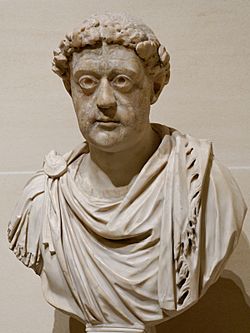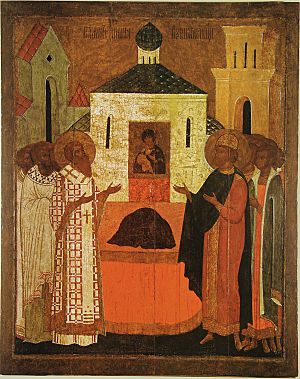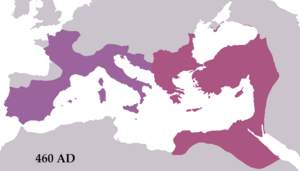Leo I (emperor) facts for kids
Quick facts for kids Leo I |
|||||
|---|---|---|---|---|---|

Portrait of Leo at the Louvre
|
|||||
| Roman emperor of the East | |||||
| Reign | 7 February 457 – 18 January 474 | ||||
| Coronation | 7 February 457 | ||||
| Predecessor | Marcian | ||||
| Successor | Leo II | ||||
| Western emperors |
Majorian (457–461) Severus III (461–465) Anthemius (467–472) Olybrius (472) Glycerius (473–474) |
||||
| Born | c. 401 Dacia Aureliana |
||||
| Died | 18 January 474 (aged 73) Constantinople |
||||
| Spouse | Verina | ||||
| Issue | Ariadne, Leontia, unnamed son | ||||
|
|||||
| Dynasty | Leonid | ||||
| Saint Leo the Great |
|
|---|---|

|
|
| Holy and Right-Believing Emperor of the Romans | |
| Venerated in | Eastern Orthodoxy |
| Feast | 20 January |
| Attributes | Imperial attire |
Leo I (born around 401 – died January 18, 474) was an important Eastern Roman emperor. He ruled the Eastern Roman Empire from 457 to 474. He is also known as "the Thracian" because he came from a region near Thrace.
Leo I was a strong leader who ruled for almost 20 years. He tried many big plans to help the Western Roman Empire, which was struggling. He also wanted to get back lands that the empire had lost. He was the first Eastern Emperor to make laws in Greek instead of Late Latin. Today, he is remembered as a saint in the Eastern Orthodox Church. His special day is January 20.
Contents
Leo's Time as Emperor
Leo was born in the year 401 in a province called Dacia Aureliana. He came from a family with Thraco-Roman roots. He joined the Roman army and rose through the ranks. He became a high-ranking officer.
At first, a powerful general named Aspar helped Leo become emperor. Aspar thought Leo would be easy to control. But Leo became more independent. This caused problems between them. Eventually, Leo had Aspar removed from power.
A New Kind of Coronation
Leo's coronation as emperor happened on February 7, 457. This was a very special event. It was the first time a Christian ceremony was added to the traditional Roman way of crowning an emperor. The Patriarch of Constantinople, a high church leader, performed part of the ceremony. This showed how Roman traditions were changing to include Christian beliefs. This new Christian coronation style was later copied by rulers all over Europe.
Dealing with Challenges
Leo made an alliance with a group called the Isaurians. This helped him deal with Aspar. As part of the alliance, Leo's daughter married the Isaurian leader, Tarasicodissa. This man later became Emperor Zeno.
During Leo's rule, the Balkans faced attacks from the Ostrogoths. These were led by a young chief named Theodoric the Great. He had grown up in Constantinople and learned about Roman government and military tactics. There were also some raids by the Huns. However, these attackers could not capture Constantinople. This was thanks to the strong city walls, which had been made even stronger before Leo's time. The attackers did not have the right tools to break through them.
Helping the Western Empire
Leo also played a role in the Western Roman Empire. He chose Anthemius to be the Western Roman emperor in 467. Leo then tried a big military plan against the Vandals in 468. The Vandals were a powerful group who had taken over parts of the Western Empire.
This expedition against the Vandals was a huge effort. It involved many ships and soldiers. However, it failed because of poor leadership. This disaster cost the Eastern Empire a lot of money and many soldiers. It was a major setback for Leo.
Leo died on January 18, 474, when he was 73 years old. He passed away from an illness.
Family Life
Leo and his wife, Verina, had three children. Their oldest daughter was named Ariadne. They also had a younger daughter named Leontia. Leontia was supposed to marry Aspar's son, Patricius. But this plan was probably canceled after Aspar was removed from power in 471. Leontia later married Marcian, who was the son of Emperor Anthemius.
Leo and Verina also had a son who was born in 463. Sadly, he died when he was only five months old.
See also
 In Spanish: León I (emperador) para niños
In Spanish: León I (emperador) para niños
- Church of St. Mary of the Spring (Istanbul)
- Life-giving Spring
- List of Byzantine emperors


